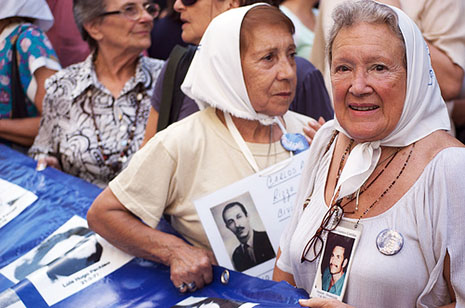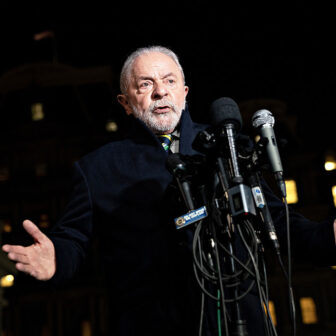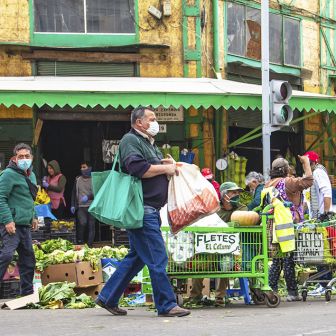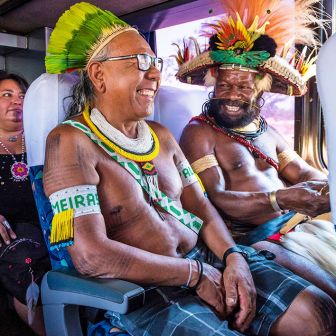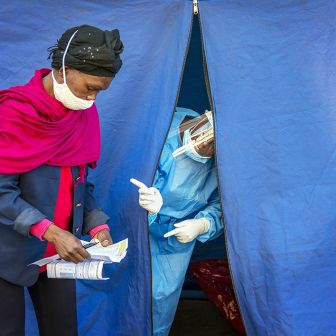DECEMBER this year will be the thirtieth anniversary of Argentina’s Comisión Nacional sobre la Desaparición de Personas, or CONADEP, the independent commission set up in late 1983 by president Raúl Alfonsín to investigate the disappearances of individuals under the direction of the military dictatorship in the years 1976–83. Alfonsín established the commission as a way of helping to create a new democracy based on peace, legality and human rights. The first-hand narratives of human rights violations under military rule were collected by CONADEP and published as Nunca Más (Never Again) in late 1984.
Nunca Más not only became a best-seller in Argentina, but was also used as the prosecution’s key resource in the trials that convicted nine of the military junta’s ex-commanders in 1985. CONADEP and Nunca Más were of great and historical significance: the commission radically influenced the course of transitional justice, and prompted the creation of subsequent “truth commissions” in neighbouring Latin American countries as well as in South Africa and other countries further afield. The director of Human Rights Watch called Argentina’s CONADEP “the most successful effort of the decade anywhere in Latin America, and perhaps worldwide, to hold accountable those who committed gross abuses of human rights.”
But the legacy of this “most successful effort” is mixed, as a conversation with human rights campaigner Maria del Socorro Alonso soon reveals. When I met Maria, she was wearing a badge showing a photo of her partner, Guillermo Oscar Sigalli, who was a fourth-year architecture student before he was abducted and “disappeared” by the military’s security forces in 1978. Maria was four months pregnant at the time. Though they were initially incarcerated together, Maria has no idea what happened to Guillermo, and nobody has ever been held accountable for his disappearance.
When we spoke, Maria had just given her oral testimony at the Tribunal Oral Federal 6, a court located in the Argentine capital of Buenos Aires, in one of the 280 trials initiated by the government of the current president, Cristina Fernández de Kirchner, in 2010. Her testimony described the torture she suffered at Campo de Mayo, a clandestine detention centre that operated in Buenos Aires during the military dictatorship. An eyewitness to the military’s human rights abuses, Maria told me about the risks she takes by speaking publicly about her experiences, and the fear she has for the safety of her children. She told me how unsafe she feels living in a society where those who were responsible for gross human rights violations during the years of military rule continue to live with impunity.
Maria told me that she lost her unborn baby as a result of the torture she endured at the hands of one of the dictatorship’s worst offenders. She encountered this man again many years later in a downtown Buenos Aires cafe and he made an off-hand, flirtatious remark to her. Outraged, Maria yelled, “Don’t you know me? You don’t have the right to say anything to me.” The offender replied, “Be grateful. You were one of the lucky ones.”
“It angers me that justice in this country is not used in a way that finishes with this business,” says Maria, “because the longer this goes on, the sicker Argentina becomes as a society. It’s thirty-three years ago! Can you believe it? A country that doesn’t want to heal itself; that doesn’t want to begin anew.”
I began to wonder how to make sense of this striking contradiction within contemporary Argentina. The country has fought to impose legal, political and social accountability on those who committed gross human rights abuses, and has become an exemplar of transitional justice; and yet many Argentinians, like Maria, believe that the justice is incomplete.
An estimated 30,000 individuals were “disappeared” by the ruling military junta between 1976 and 1983, and in many cases the bodies have never been recovered. Up to 500 children were taken from their incarcerated mothers and given to families with close military ties, and are still unaware of their real identities. Thirty years later, victims continue to encounter their torturers in the street. The relatives of the disappeared are concerned that the violence that pervaded Argentine society in the 1970s and 1980s is not finished; they fear a future in which their children will experience the same terror.
In her widely praised book A Lexicon of Terror: Argentina and the Legacies of Torture, Marguerite Feitlowitz conveys the apprehension that runs so deeply in Argentine society: “There is constant vigilance, the certainty of disaster, carnal knowledge of fear, a sense that history never moves on, but circles, raven-like, round and round.” You only have to visit the Plaza de Mayo in central Buenos Aires any Thursday afternoon to witness Feitlowitz’s powerful observation played out time and again. Members of the organisation Madres de los desaparecidos (Mothers of the Disappeared) circle around the plaza in their weekly vigil, demanding to be told the truth about what happened to every one of their missing children, and demanding the legal redress of human rights violations committed under the ruling military junta between 1976 and 1983.
Exactly what happened to victims of abduction by the security forces remains a complete mystery for most families. The military has refused to accept responsibility for human rights abuses and former and current members live freely in society. Graciela Lois, whose husband was disappeared in 1976, provides one explanation of the military’s thinking, advanced by an official in the US embassy. “He told me about a theory that the military had… I remember that he spoke of the pendulum theory,” she says. “It’s time. The pendulum is time. The time passes, people get old, they die and the protest ends. This is what one sector of the military thought.”
The governments of presidents Néstor Kirchner (2003–07) and his wife Cristina Fernández de Kirchner (2007–present) have taken concrete steps to interrupt the swing of the pendulum. They have endorsed new cultural models of collective remembrance and commemoration by formalising the idea of memory as a national duty. For example, the anniversary of the 1976 coup d’état, 24 March, has been transformed into a National Day of Memory, Truth and Justice. They have also confronted the legacy of human rights violations by the armed forces by providing monetary reparations to victims and victims’ families, and reclaiming former clandestine detention centres to be used as sites of remembrance. And in 2010, the government initiated the 280 judicial trials of those in the military and security forces accused of human rights violations during the dictatorship.
But many in Argentine society are fearful that these very recent and hard-fought gains could be lost with a change of government. This has happened before. Alfonsín’s successor, Carlos Menem, adopted a policy of forgetting the past when, on taking power in 1989, he extended pardons to those in the military who had been convicted of human rights crimes. In a further symbolic gesture of national reconciliation, Menem even coordinated the public auction of 146 of the infamous green Ford Falcons used by the police and paramilitary groups to kidnap thousands of individuals and whisk them away to the clandestine detention centres. These cars can still be seen on the streets, another daily, visceral reminder of the terror of the past.
In his play Death and the Maiden, Ariel Dorfman explores the sorts of dilemmas faced by a population when a government has embraced impunity and policies of forgetting in the name of national reconciliation. “How can the repressors and the repressed live in the same land, share the same table?” he writes. “How to heal a country that has been traumatised by fear if that same fear continues to do its silent work?”
In Argentina, fear is still doing its silent work. Living side by side with the dictatorship’s repressors has become a part of everyday life.
MEANWHILE, individuals on the political right claim that the Kirchner governments have also adopted impunity and policies of forgetting. The testimonial narrative of Nunca Más established part of what had happened during the years 1976–83, but it also sent a clear message about what should be left behind or forgotten. Victims of the armed left-wing movement active in 1973–76 were not included in the CONADEP report. Conservatives challenged the report, arguing that it did not make mention of these crimes, and CONADEP leader Ernesto Sabato was forced to respond to accusations of partiality. “It was not our task to look into the crimes committed by those terrorists, but simply to investigate the fate of the disappeared, whoever they were, and from whichever side of the violence they came,” Sabato wrote. “None of the relatives of the victims of that earlier terror approached us because those people were killed rather than ‘disappeared.’”
It wasn’t the commission’s central role to investigate the violent activities of the armed guerrilla groups, but the omission meant that certain groups’ experiences were not recognised in this new chapter of Argentine history. Vittoria Villaruel from the victim advocacy group El Centro de Estudios Legales sobre el Terrorismo y sus Victimas, or CELTYV, told me that the organisation had initiated thousands of lawsuits over recent years. Many of the families feel they have been denied justice because the state has refused to investigate their claims. Vittoria told me that she herself has been labelled a fascist for demanding human rights on behalf of the organisation’s victims. “We’re being called Nazis for defending innocent people,” she said.
She also described how it feels for those who exist on the margins of a society that “lumps” them together with those in the military who committed human rights abuses. “We are living in a situation of inequality in Argentina; a situation that is lacking in objectivity and impartiality,” she told me. “The state looks after the rights of the civilians from one part of society while the other part has nothing. So these people, when they speak with someone like you, are left with the feeling that they are nobody; that they don’t count.”
Lorenza Ferrari, whose only daughter Laura was critically wounded in a car bomb that exploded outside the front gate of her university in 1975, told me that being forgotten only increased her pain and sense of denigration. “Right now is when I feel saddest,” she said. “I feel forgotten, I feel... not forgotten really because I don’t want anyone to remember me but I feel... discriminated [against]... I’m not saying that others’ pain should be ignored but they [the government] are ignoring mine completely, completely.”
She described feeling like she exists on the edge of society, in a no man’s land, because her daughter Laura, who was apolitical, was in the wrong place at the wrong time when a car bomb planted by the armed guerrilla movement exploded. “These were political ideas that weren’t mine, that weren’t of my family, that weren’t of Laura. And we were victims of these political ideas.”
Lorenza has sought support from CELTYV, not because she identifies in any way with the political right, but because her daughter was killed in an attack by the armed guerrilla movement. With the current government uninterested in her claim for recognition, she feels she has nowhere else to turn. Though she is not politically affiliated, Lorenza still finds herself caught up in the middle of “competitive remembering.” Her story shows how someone can be co-opted into a political discourse because they have nowhere else to turn.
There are members of the leftist guerrilla group, the Montoneros, in today’s government, Lorenza believes. “I’m not saying they were Laura’s killers,” she says, “But as a political idea, they are in government and they are the same ones that won’t acknowledge what happened to me and to others. That’s to say, the military have someone to defend them, the Montoneros have someone to defend them. But who’s going to defend me? Me, my son, my husband, nobody has come near us; no government has ever looked after our mental health because I’ll tell you, insanity is waiting at the door. It only has to open it.”
ARGENTINE scholar Elizabeth Jelin suggests that whenever Argentina experiences political change, debates surface over how to remember – or forget – the period of repression and political violence in the 1970s and 1980s. Participants in these debates have linked their political programs and orientations to the memories of a violent past, preserving the fissures of decades-old, deep-seated social and political animosity. It is as if different memories vie for pre-eminence in a constant struggle for political, social and legal recognition in which, once again, there are only winners and losers. The result is a society of “memory groups,” with each claiming recognition and legitimacy.
Argentine writer Graciela Scheines likens Argentine history to a “living burden” that produces “sorrow and anguish.” Widespread abuses by the state and armed political groups have left behind a powerful legacy of pain in Argentina. This was abundantly clear when women told me about their traumatic experiences. They seemed to speak with the same emotional charge as they would have thirty years earlier when they gave their first public testimonies. Women from both left and right were as committed as ever to the daily task of bearing witness to those experiences that had irrevocably changed the course of their lives.
Argentina’s experience demonstrates that truth-telling and reparation mechanisms, such as truth commissions, do not always achieve the “healing” that is intended. Indeed, as memory studies researcher Ann Rigney acknowledges, reconciliation efforts in post-conflict contexts have more often than not yielded a “thin” form of “mere co-existence” rather than the “thicker” form of “social integration and solidarity invoked by redemptive narratives of ‘national reconciliation.’” This is certainly true for Argentina, where the public performance of witnesses’, victims’ and perpetrators’ stories of political and state violence has not been a catalyst for collective psychological or socio-emotional reconciliation. For most of the women I interviewed, talking about their traumatic memories in the form of oral testimony has not played any such role in helping them deal with their painful memories.
Through the act of remembering, the families of victims of the military and armed guerrilla movement are not attempting to heal their wounds; in their minds, this would deny justice its due. Instead, both groups of women give their painful testimonies to ensure that crimes committed continue to have a moral reality within Argentine society. In the face of so much uncertainty, they wish at least to be certain that the truth of what happened to their loved ones does not become separated from the passage of time, and that time does not exonerate perpetrators. Forty years on, this legacy of violence is far from being resolved. As one victim said to me, “This story is without an ending.” •
